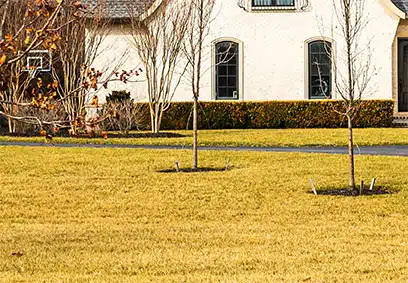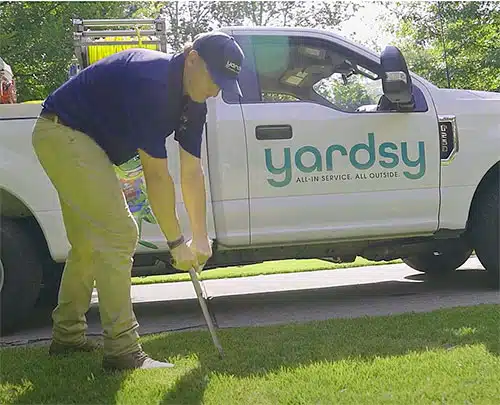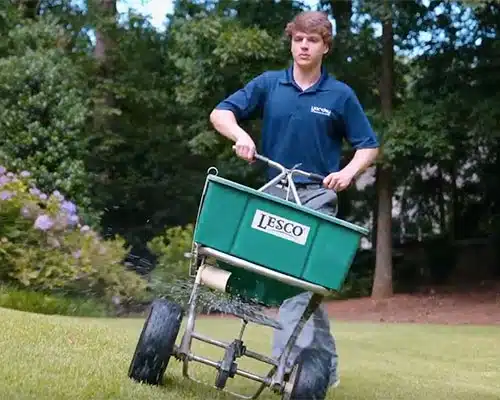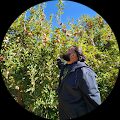Many homeowners wonder why the neighbor’s grass is greener when comparing their lawns to others. Let’s unravel this mystery and investigate why lawns look different, what influences grass color, and what you can do to cultivate a lush, vibrant lawn.
Solving the Neighbor’s Grass Is Greener Puzzle: Different Types of Grass
A piece in the “neighbor’s grass is greener” puzzle is understanding the type of grass you and your neighbor have. Grass types vary significantly in how they grow, their color, and their seasonal color changes. Let’s compare the two main types of grasses, warm-season and cool-season, to understand why it might seem that the neighbor’s grass is greener:
Warm-Season Grasses: Bermuda and Zoysia
Warm-season grasses like Bermuda and Zoysia flourish in warm temperatures. These grasses are predominantly found in the Southern states of the U.S., where the climate is most conducive to their growth. However, warm-season grasses can also be found in areas with mid-range climates. Warm-season grasses are most active and green during the summer when the sun is strong and the days are long. In spring, they are slower to green up than other types of grasses.

During the warmer months, these grasses peak, displaying a lush, vibrant green color. As the season transitions to late autumn, they enter a dormant phase. This dormancy is a natural process where the grass conserves energy and resources, leading to a brown or less vibrant appearance.
Cool-Season Grasses: Fescue
Fescue and other cool-season grasses thrive in cooler temperatures. These grass types are more common in the Northern states. The cooler climate of these regions suits the growth patterns of cool-season grasses. Cool-season grasses can also be found in areas with mid-range climates. Generally, they are most active and colorful in spring and fall when the temperatures are mild.
In the heat of the summer or during very cold temperatures, cool-season grasses can enter a dormant state. Cool-season grasses may lose some of their green vibrancy during their dormant periods. In regions that don’t experience significant temperature swings, these grasses can maintain a relatively green appearance throughout the year.
Comparing Lawns In Your Neighborhood
Depending on where you live, you and your neighbors may have different types of grass. Individual homeowners may even have more than one type of grass within their yards. For example, you might grow Zoysia or Bermuda on your front lawn and fescue in the backyard.
If you have warm-season grass and your neighbor has cool-season grass, that could explain why your neighbor’s grass is greener than yours during various times of the year. Your neighbor might have a type of grass that’s in its peak growing season while your grass is dormant or just starting to green up, or vice versa.
Differences In Soil pH

Another piece of the “neighbor’s grass is greener” puzzle relates to the pH level of your soil and the nutrients available to your grass. Soil pH levels can significantly influence lawn health and grass color. If your soil is too acidic or too alkaline, your grass will not thrive. Correcting the pH balance of your lawn can lead to a healthier, greener lawn.
Soil testing is the best way to determine if a pH imbalance is preventing your grass from looking as green as your neighbor’s grass. Testing the pH level in your soil and choosing the proper soil amendments are crucial for maintaining a vibrant, colorful lawn. If your neighbor’s soil is in the proper pH range and yours is not, this could explain why your neighbor’s grass is greener.
Differences In Soil Nutrients
The greenness of your lawn heavily depends on essential nutrients like nitrogen, potassium, and phosphorus. Nitrogen enhances leaf growth and color, potassium boosts overall health, and phosphorus strengthens root systems. If your soil lacks these critical nutrients, you can fertilize your lawn to increase nutrient levels. Be sure to correct any pH problems first. An off-balance soil pH can hinder your lawn’s ability to utilize nutrients effectively, even if you add fertilizer. If your grass is not experiencing the same pH balance and level of nutrient absorption as your neighbor’s, that could explain why your neighbor’s grass is greener.
Overseeding Techniques
One lawn maintenance strategy that might explain why your neighbor’s grass is greener is overseeding, particularly for warm-season lawns. Overseeding involves adding a new layer of grass seeds to an existing lawn, which can revitalize and thicken it.

Overseeding with cool-season ryegrass is common for lawns with warm-season grasses like Bermuda or Zoysia. This keeps lawns green because cool-season ryegrass can tolerate lower temperatures and remain green longer, even when the warm-season grasses have turned brown and entered their dormant phase.
The result of overseeding in fall is a lawn that maintains its green appearance longer. If your neighbor is overseeding their warm-season grass and you are not, that might be another reason your neighbor’s grass is greener than yours.
Water and Mow Based on Your Grass Type
Tailoring lawn care to your grass type is vital to a greener lawn. Warm-season grasses, like Bermuda and Zoysia, flourish with more frequent watering and higher nitrogen fertilizer during summer. In contrast, cool-season grasses like Fescue do better with less frequent watering and fall or spring fertilization. Also, adjusting mowing height and frequency based on the grass type is crucial. Adapting these lawn care aspects to your grass’s needs can improve its health and vibrancy, leading to a noticeably greener lawn. If your neighbor’s grass is greener, their watering and mowing techniques might differ from yours.
Understanding Why Your Neighbor’s Grass Might Be Greener
To solve the mystery of why your neighbor’s grass is greener, evaluate your grass type, soil pH, nutrient levels, overseeding practices, and lawn care practices. It’s possible that by implementing a few changes, your grass can be greener and healthier. For expert advice and top-notch lawn care services, contact Yardsy.com. Let us help you make your lawn the envy of the neighborhood!



















































